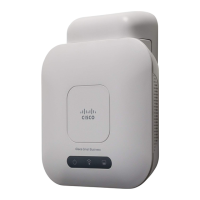Wireless
Quality of Service
Cisco WAP571/E Administration Guide 109
5
STEP 1 Select Wireless > QoS in the navigation pane. Select the radio interface on which
to configure QoS settings (Radio 1 or Radio 2).
STEP 2 Select an option from the EDCA Template list:
• WFA Defaults—Populates the WAP device and Station EDCA parameters
with WiFi Alliance default values, which are best for general, mixed traffic.
• Optimized for Voice—Populates the WAP device and Station EDCA
parameters with values that are best for voice traffic.
• Custom—Enables you to choose custom EDCA parameters.
These four queues are defined for different types of data transmitted from WAP-
to-station. If you choose a Custom template, the parameters that define the queues
are configurable; otherwise, they are set to predefined values appropriate to your
selection. The four queues are:
• Data 0 (Voice)—High priority queue, minimum delay. Time-sensitive data
such as VoIP and streaming media are automatically sent to this queue.
• Data 1 (Video)—High priority queue, minimum delay. Time-sensitive video
data is automatically sent to this queue.
• Data 2 (Best Effort)—Medium priority queue, medium throughput and
delay. Most traditional IP data is sent to this queue.
• Data 3 (Background)—Lowest priority queue, high throughput. Bulk data
that requires maximum throughput and is not time-sensitive is sent to this
queue (FTP data, for example).
STEP 3 Configure the following EDCA and Station EDCA parameters:
NOTE These parameters are configurable only if you selected Custom in the
previous step.
• Arbitration Inter-Frame Space—A wait time for data frames. The wait time
is measured in slots. Valid values for AIFS are 1 through 255.
• Minimum Contention Window—An input to the algorithm that determines
the initial random backoff wait time (window) for retry of a transmission.
This value is the upper limit (in milliseconds) of a range from which the initial
random backoff wait time is determined.
The first random number generated is a number between 0 and the number
specified here.

